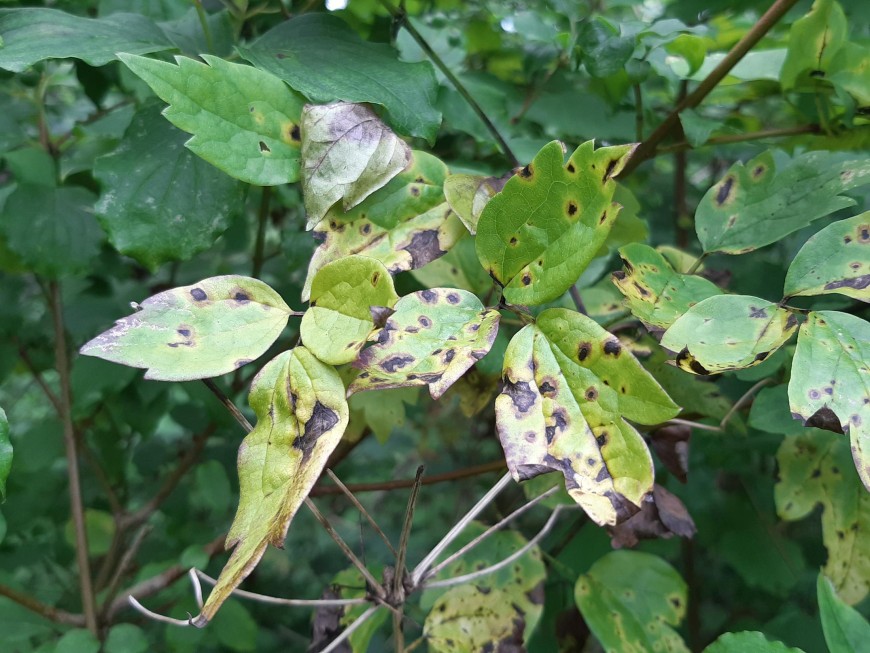Old Man’s Beard Pathogens
In 2021 we embarked on a fresh search for old man’s beard pathogens in its native range, in collaboration with plant pathology researchers from the Centre for Agriculture and Bioscience International (CABI) in the United Kingdom. Field surveys were undertaken across the UK and Europe, focusing on regions that are climatically similar to New Zealand and where old man’s beard proliferates. Fungal isolations were made throughout these regions from all old man’s beard leaves displaying pathogenic symptoms.

Image: Longididymella vitalbae on old man's beard.
Since the introduction of the Phoma clematidina pathogen into New Zealand in the 1990s, two major taxonomic reviews of the Phoma genus have been undertaken. Consequently, a new genus, Longididymella, was described, including only two species - Longididymella clematidis and L. vitalbae. Molecular analysis of the fungal isolates collected from the UK and Europe indicated that the most prevalent pathogen infecting old man’s beard leaves in its native range is the latter species, L. vitalbae. This species was originally described from old man’s beard in Switzerland, France, Germany, and the Netherlands. Interestingly, the molecular study also showed that the original pathogen, called ‘Phoma clematidina’ when released in New Zealand in 1996, was in fact the other Longididymella species, L. clematidis.
The next step for the biocontrol programme for old man’s beard was to determine whether the strain of the pathogen collected in the UK and Europe can cause disease on old man’s beard from New Zealand. Old man’s beard has an extensive native range, spanning regions from southern England and the Netherlands to North Africa, and from Spain to the Middle East and the Caucasus. Population genetics studies conducted in 2019 also revealed a diverse range of old man’s beard populations in New Zealand, which were most closely matched genetically with old man’s beard from the UK, Germany, and France.

Image: Longididymella vitalbae on detached leaf.
However, a more recent population genetics study, led by molecular ecologist, Caroline Mitchell, analysed a larger subset of old man’s beard samples collected in the UK and Europe. This study identified five distinct genotypes throughout the native range, with varying prevalence in different regions. Remarkably, all five of these genotypes appear to be present in New Zealand, with different regions hosting a mixture of genotypes. This suggests that old man’s beard was introduced into New Zealand on multiple occasions from different sources, followed by deliberate spread across the country.
The most prevalent old man’s beard genotype in New Zealand shares similarities with genotypes from the UK and Italy, while other genotypes correspond to those from Germany and Sicily. Another genotype hails from Serbia, and the least common one originates from other European countries.
To determine whether the new species of the old man’s beard pathogen can cause disease on New Zealand genotypes of the weed, plants had to be propagated from seed exported to the UK in August 2022. In the spring of 2023 Dr Sarah Thomas (Plant Pathologist, CABI) successfully inoculated detached old man’s beard leaves using mycelial plugs. Whole inoculations of three of the five New Zealand genotypes to test pathogenicity are currently underway. If the pathogenicity testing doesn't show a significant variance among the three old man’s beard genotypes currently being tested, we can reasonably assume a similar trend for the remaining two genotypes.
The isolate in the current study that seems to offer the most potential for biocontrol of old man’s beard has been confirmed as L. vitalbae, originating on the target host plant species, old man’s beard. The recently identified genetic diversity within old man’s beard populations in New Zealand presents both challenges to and opportunities for developing tailored biological control strategies that account for genotype-specific interactions.
This project was jointly funded by the National Biocontrol Collective and the Ministry for Primary Industries’ Sustainable Food and Fibre Futures Fund (Grant #20095) on multi-weed biocontrol.
